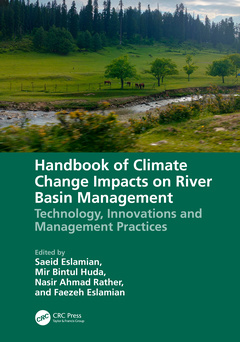Handbook of Climate Change Impacts on River Basin Management Technology, Innovations and Management Practices
Coordonnateurs : Eslamian Saeid, Huda Mir Bintul, Rather Nasir Ahmad, Eslamian Faezeh A.

Climate change not only involves rising temperatures but it can also alter the hydro-meteorological parameters of a region and the corresponding changes emerging in the various biotic or abiotic environmental features.
One of the results of climate change has been the impact on the sediment yield and its transport. These changes have implications for various other environmental components, particularly soils, water bodies, water quality, land productivity, sedimentation processes, glacier dynamics, and risk management strategies to name a few.
This volume provides an examination of the technological approaches to water management, and the practical applications for remote sensing, satellite image processing, and advanced statistical methods, all which can be utilized to predict, monitor, and manage the effects of climate change on river basins.
Part I: Software Technologies. 1. Predictive Modeling Trap Efficiency of Detention Dams using Soft-Computing. 2. Software Technologies for Studying Runoff and Sediment Yield. 3. Application of Soft-Computing in Sediment and Erosion Modelling. 4. MONITORING AND MAPPING OF WETLANDS USING GIS. 5. Estimation of Sub-basin Annual flow Using GIS. 6. Remote Sensing and Geographic Information Systems for River Management. 7. Potential impacts of climate change: Importance of Using GIS for its management. 8. Investigating the effects of agricultural management on wheat plant productivity gap using Aqua-Crop software. 9. Evaluating the Effect of Climate Change on Soil Erosion using Remote Sensing and Satellite Image Processing. 10. Markov Chain and Monte Carlo Methods: Application for Head Loss Determination. 11. Structuring of a Model for Risk Evaluation of Worker Exposure to Gypsum Dust. Part II: Management Practices. 12. Integrated Water Resources Management and Sediment. 13. Application of Mathematical Advances for Management of Groundwater Resources using Coastal Land Reclamation Considering the Climate Challenges by Sea Level Rise. 14. Soil Erosion Control. 15. Museum Emergency Management and Disaster Risk Reduction Strategies. 16. Irrigation for Soil Salinity Control. Part III: Recent Innovations. 17. Climate Adaptation and Water-Environment-Energy Nexus. 18. A Collective Voluntary Disaster Insurance Using the Property-Tax and Coverage of Low-Income People. 19. Transboundary Resilience and Social-Hydrological Systems. 20. Sustainable Green Buildings and Infrastructure for Climate Resilience. 21. Sedimentation, Erosion, and Resilience. 22. Consequences of Coastal Erosion, Displacement and Community Relocation. 23. Recent Progresses in Dam Reservoir Sediment Estimation and Control. 24. Bankfull Stage and Discharge : A Comprehensive Review.
Prof. Saeid Eslamian is a full professor of environmental hydrology and water resources engineering in the Department of Water Engineering at Isfahan University of Technology, where he has been since 1995. His research focuses mainly on statistical and environmental hydrology in a changing climate. In recent years, he has worked on modeling natural hazards, including floods, severe storms, wind, drought, pollution, water reuses, sustainable development and resiliency, etc. Formerly, he was a visiting professor at Princeton University, New Jersey, and the University of ETH Zurich, Switzerland. On the research side, he started a research partnership in 2014 with McGill University, Canada. He has contributed to more than 600 publications in journals, books, and technical reports. He is the founder and chief editor of both the International Journal of Hydrology Science and Technology (IJHST). Eslamian is now associate editor of three important publications: Journal of Hydrology , Eco-Hydrology and Hydrobiology, Journal of Water Reuse and Desalination (IWA) and Journal of the Saudi Society of Agricultural Sciences. Professor Eslamian is the author of more than 40 books and 200 chapter books.
Dr. Mir Bintul Huda (B.Tech, M.Tech, AMIE, Ph.D.) is presently a Consultant at Water Resources Management Centre, National Institute of Technology Srinagar, Jammu & Kashmir. Her work is on Water Resources, Climate Change Impacts and adaptation of strategies with respect to Planning and Management of Water Resources Systems of Indus Basin. Dr. Mir received Ministry of Human Resources Development (MHRD) Doctoral fellowship from Government of India and earned her Doctorate in Civil Engineering with majors in Water Resources Engineering from National Institute of Technology Srinagar. She did her Masters of Technology in Water Resources Engineering from NIT Srinagar. She has done her Bachelors in Agricultural Engineering from Sher-e-Kashmir University of Agricu
Date de parution : 05-2024
17.8x25.4 cm



